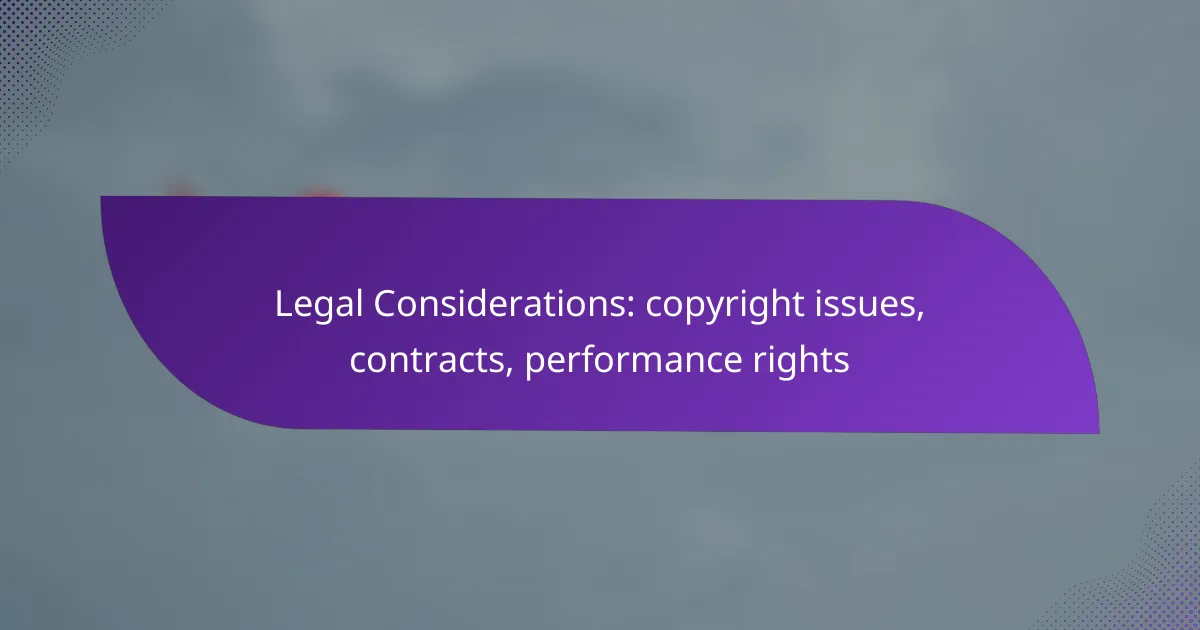Understanding legal considerations surrounding copyright issues, contracts, and performance rights is essential for creators and performers alike. Copyright laws protect original works, while contracts define the terms of use and compensation for these works. Performance rights agreements further clarify how copyrighted material can be utilized in performances, ensuring that both artists and rights holders are fairly represented.
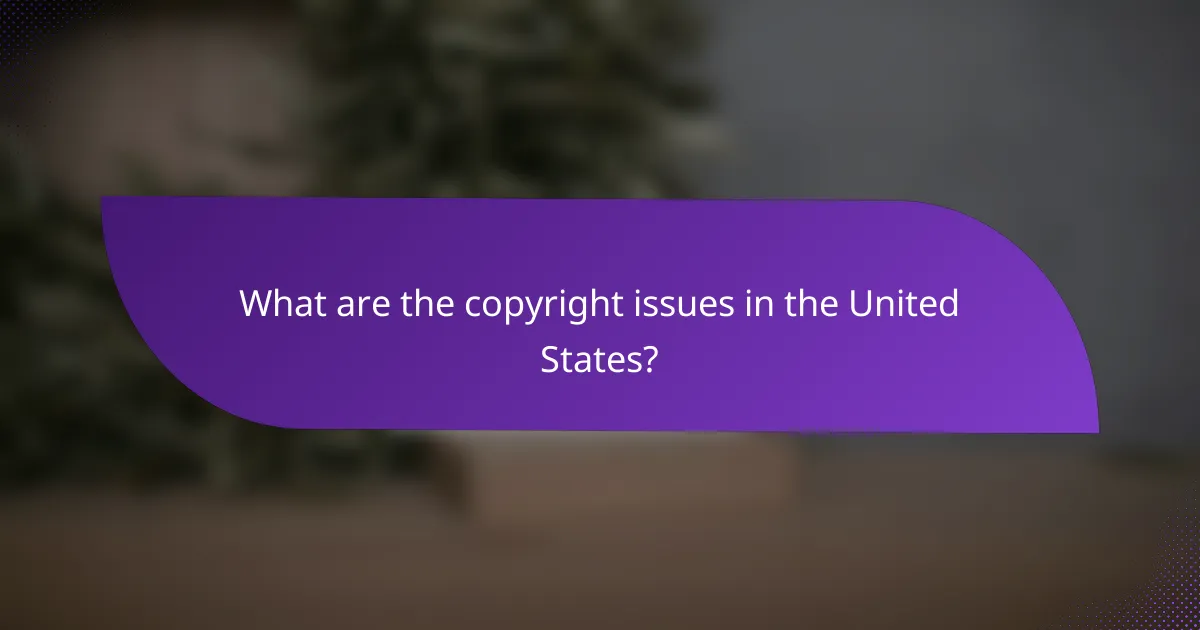
What are the copyright issues in the United States?
Copyright issues in the United States revolve around the protection of original works, including literature, music, and art. Understanding these issues is crucial for creators and users to navigate rights, permissions, and potential infringements effectively.
Fair use doctrine
The fair use doctrine allows limited use of copyrighted material without permission from the copyright owner. This principle is often applied in contexts such as criticism, comment, news reporting, teaching, scholarship, or research.
Determining fair use involves evaluating factors like the purpose of use, the nature of the copyrighted work, the amount used, and the effect on the market value of the original work. For example, using a short clip from a movie for educational purposes may qualify as fair use, while using an entire film for commercial gain likely would not.
Copyright infringement
Copyright infringement occurs when someone uses a copyrighted work without authorization from the copyright holder. This can include reproducing, distributing, or publicly displaying the work without permission.
Infringement can lead to legal consequences, including monetary damages and injunctions. To avoid infringement, always seek permission or licenses for copyrighted materials, and consider using works that are clearly marked as available for public use.
Public domain works
Public domain works are those not protected by copyright, meaning they can be freely used by anyone. Works can enter the public domain when copyright expires, or if the creator waives their rights.
Examples of public domain works include classic literature, government publications, and certain older films. Utilizing public domain materials can be a valuable resource for creators looking to avoid copyright issues while still accessing a wealth of creative content.
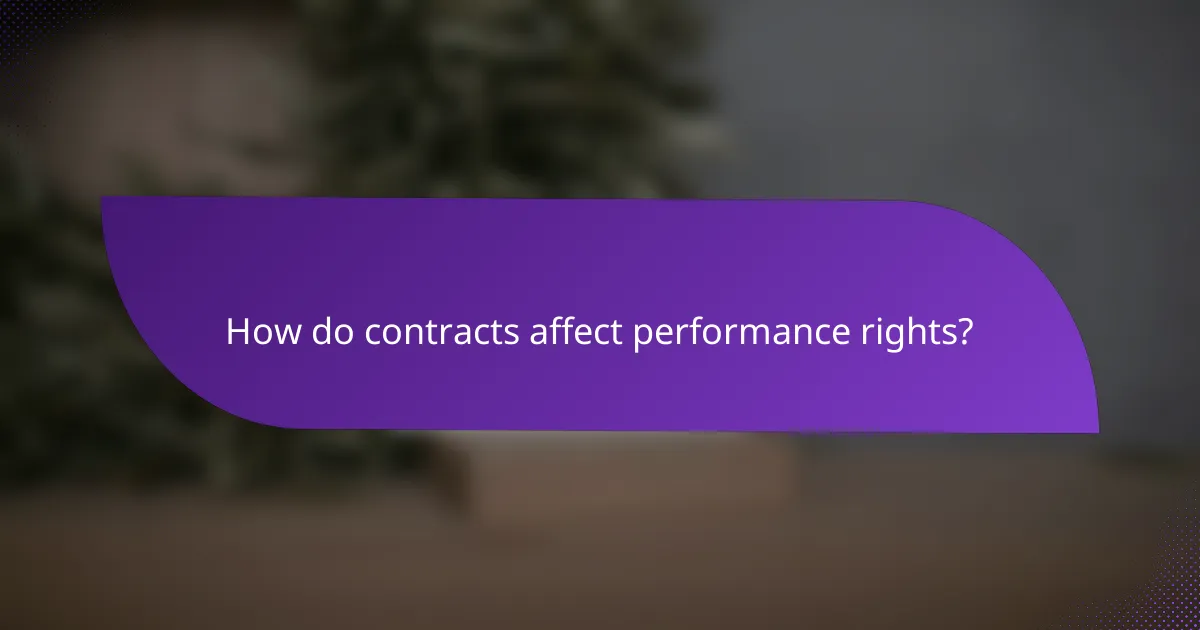
How do contracts affect performance rights?
Contracts play a crucial role in defining performance rights by outlining the terms under which artists can perform their works. These agreements specify who holds the rights, how they can be used, and any compensation involved, making them essential for both performers and rights holders.
Contractual obligations
Contractual obligations detail the responsibilities of each party involved in a performance agreement. For instance, a performer may be required to deliver a specific number of shows, while the venue must ensure adequate facilities and promotion. Breaching these obligations can lead to legal disputes and financial penalties.
It’s important to clearly outline all obligations in the contract to avoid misunderstandings. Both parties should review the terms carefully, ensuring that expectations regarding performance dates, payment schedules, and rights management are explicitly stated.
Negotiating performance rights
Negotiating performance rights involves discussions between artists and rights holders to determine how a work can be used in performances. This includes aspects like duration, territory, and exclusivity of the rights granted. Clear negotiation can prevent conflicts and ensure fair compensation.
When negotiating, consider the potential for future performances and the scope of rights needed. For example, if an artist plans to tour internationally, they should secure global rights rather than just local ones. Always document the agreed terms to protect both parties’ interests.
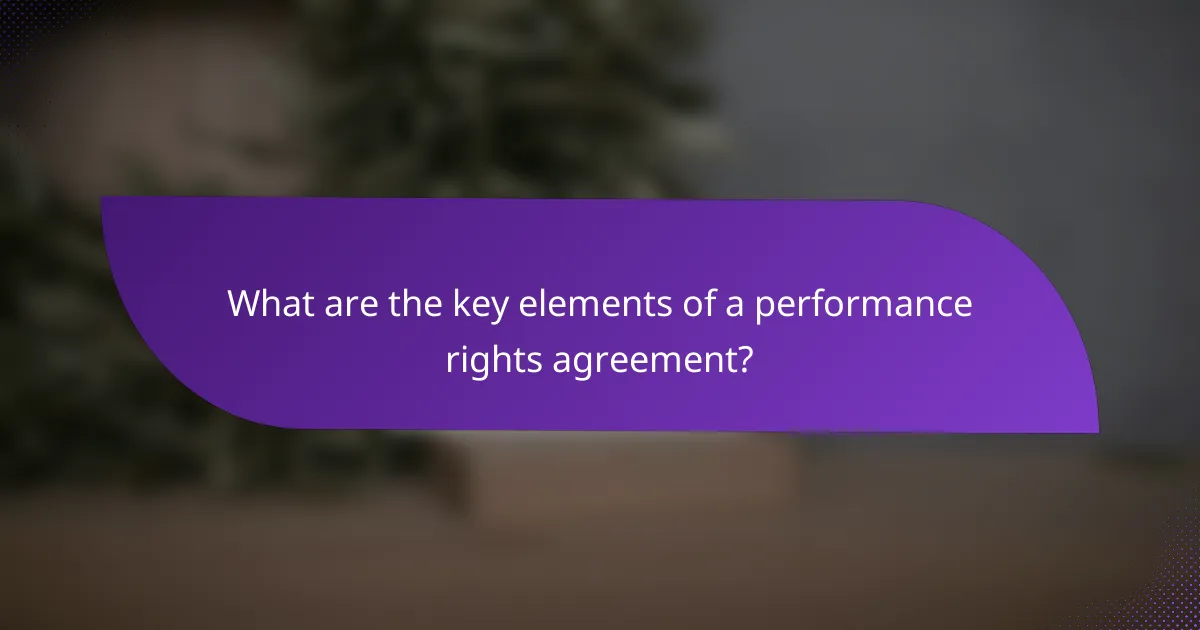
What are the key elements of a performance rights agreement?
A performance rights agreement outlines the terms under which a performer can use copyrighted material in their performances. Key elements include the scope of rights granted, the duration of the agreement, and the royalty structures involved.
Scope of rights
The scope of rights in a performance rights agreement defines what the performer is allowed to do with the copyrighted material. This can include live performances, broadcasts, and digital streaming. It’s crucial to specify whether the rights are exclusive or non-exclusive, as this affects the performer’s ability to use the material in various contexts.
For example, an exclusive right may prevent the copyright holder from granting similar rights to others, while a non-exclusive right allows multiple performers to use the same material. Clear definitions help avoid disputes over usage and ensure both parties understand their limitations and freedoms.
Duration of agreement
The duration of the agreement specifies how long the performance rights are valid. This can range from a single event to multiple years, depending on the nature of the performance and the agreement between the parties. It’s essential to consider whether the duration aligns with the expected use of the material.
For instance, if a performer plans to use a song for a series of concerts, a longer duration may be beneficial. Conversely, a shorter duration might be suitable for a one-time event. Clearly stating the duration helps both parties manage their expectations and obligations.
Royalty structures
Royalty structures determine how performers will compensate copyright holders for the use of their material. This can include upfront fees, percentage-based royalties, or a combination of both. Understanding the financial implications of different structures is vital for both parties.
For example, a flat fee may be simpler but could limit potential earnings for the copyright holder, while a percentage-based structure may provide ongoing revenue. It’s important to negotiate terms that reflect the value of the material and the expected audience size, ensuring a fair arrangement for all involved.

What are the legal frameworks for copyright in creative industries?
The legal frameworks for copyright in creative industries encompass various laws and treaties that protect the rights of creators. These frameworks ensure that original works are safeguarded from unauthorized use, allowing creators to benefit financially from their creations.
U.S. Copyright Act
The U.S. Copyright Act provides the foundation for copyright law in the United States, protecting original works of authorship fixed in a tangible medium. This includes literature, music, film, and software, among others. Copyright protection is automatic upon creation, but registering the work with the U.S. Copyright Office offers additional legal advantages.
Creators should be aware of the duration of copyright, which typically lasts for the life of the author plus 70 years, although different rules apply for works made for hire. It is crucial to understand the limitations and exceptions, such as fair use, which allows limited use of copyrighted material without permission under certain circumstances.
International copyright treaties
International copyright treaties, such as the Berne Convention and the Agreement on Trade-Related Aspects of Intellectual Property Rights (TRIPS), establish standards for copyright protection across member countries. These treaties facilitate the recognition of copyright across borders, ensuring that creators can enforce their rights internationally.
Creators should consider the implications of these treaties when distributing their works globally. For instance, the Berne Convention mandates that member countries provide at least the same level of protection to foreign works as they do to domestic works. Understanding these agreements can help creators navigate international markets and protect their intellectual property effectively.
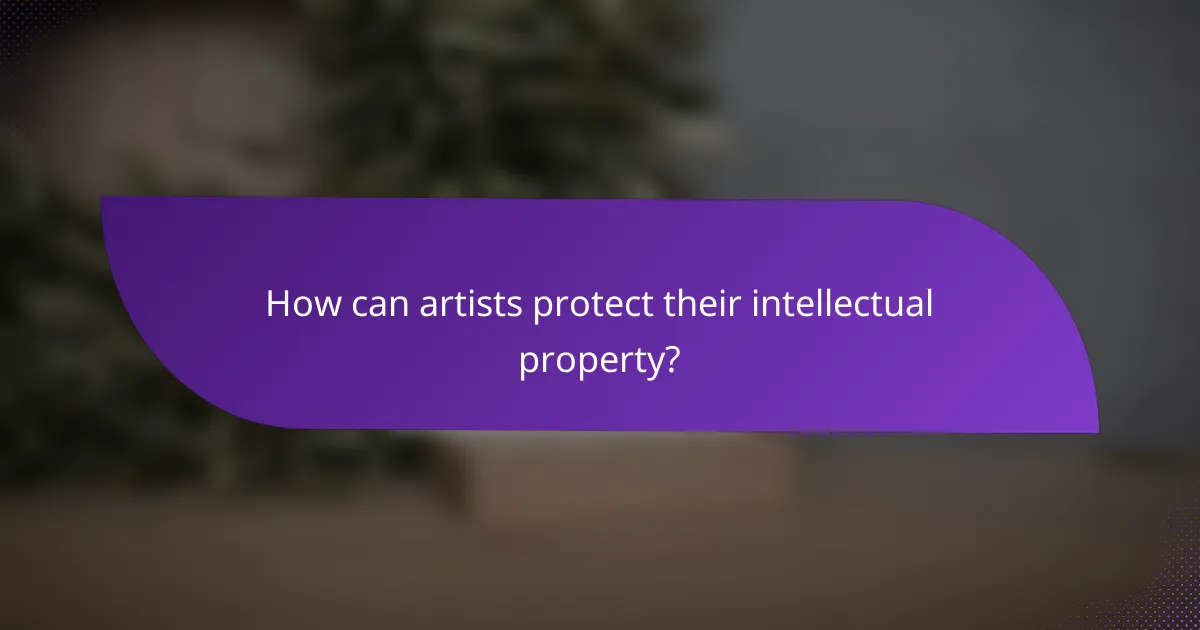
How can artists protect their intellectual property?
Artists can protect their intellectual property through various legal mechanisms, primarily copyright registration and digital rights management. These methods help secure their creative works and ensure they receive appropriate recognition and compensation.
Registering copyrights
Copyright registration is a crucial step for artists to safeguard their original works, such as music, visual art, and literature. By registering with the relevant authority, typically the U.S. Copyright Office or equivalent in other countries, artists gain legal recognition and the ability to enforce their rights against unauthorized use.
To register, artists need to complete an application, submit a copy of the work, and pay a fee, which can vary significantly depending on the type of work and jurisdiction. It’s advisable to register works as soon as they are created to maximize protection.
Using digital rights management
Digital rights management (DRM) refers to technologies that control how digital content is used and distributed. For artists, implementing DRM can help prevent unauthorized copying and sharing of their works, especially in the digital music and video industries.
Common DRM strategies include encryption, watermarking, and licensing agreements. While DRM can be effective, it may also limit the accessibility of works for legitimate users, so artists should weigh the benefits against potential drawbacks when choosing their approach.
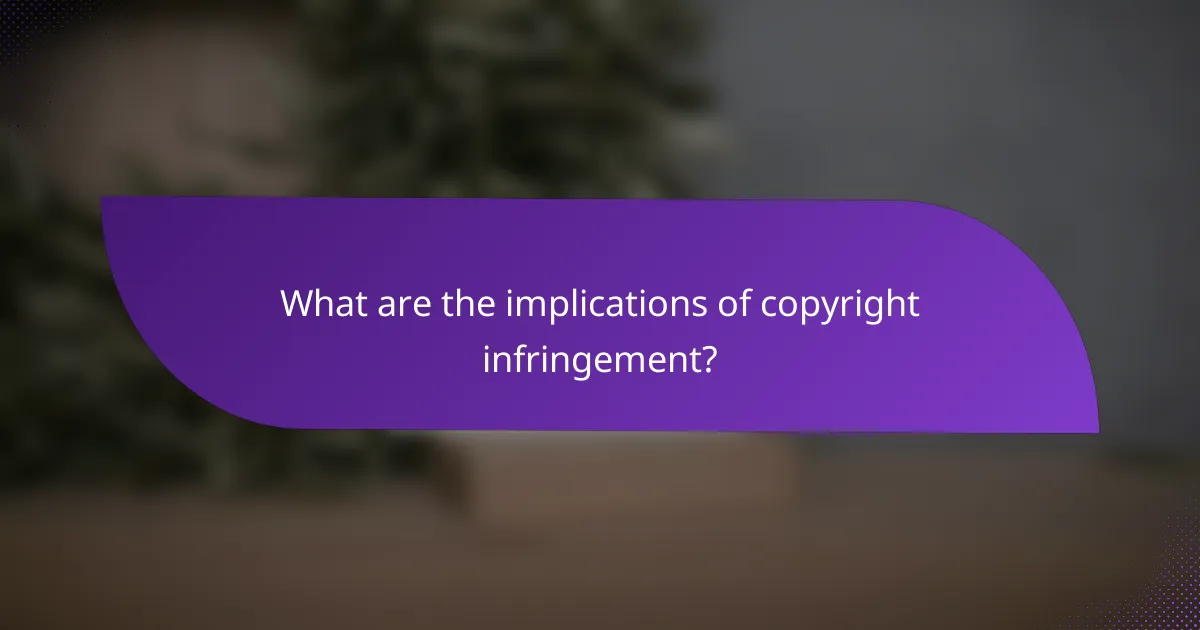
What are the implications of copyright infringement?
Copyright infringement can lead to significant legal and financial consequences for individuals and organizations. It involves unauthorized use of protected works, which can result in legal action and the need for compensation to the original creators.
Legal penalties
Legal penalties for copyright infringement can vary widely depending on the severity of the violation. In many jurisdictions, infringers may face civil lawsuits, which can result in court orders to cease the infringing activity and, in some cases, criminal charges that could lead to fines or imprisonment.
For example, in the United States, willful infringement can lead to statutory damages ranging from thousands to millions of dollars, depending on the case. Additionally, repeat offenders may face harsher penalties, including increased fines or longer prison sentences.
Financial damages
Financial damages resulting from copyright infringement can be substantial and may include both actual damages and profits gained from the infringement. Actual damages are calculated based on the losses suffered by the copyright holder, while profits refer to the earnings the infringer made from the unauthorized use.
In some cases, statutory damages can be awarded, which do not require proof of actual loss. These damages can range from a few hundred to several thousand dollars per work infringed, depending on the nature of the infringement and the jurisdiction. It is crucial for individuals and businesses to understand these potential costs to avoid infringing on copyright laws.

What are the emerging trends in copyright law?
Emerging trends in copyright law reflect the rapid evolution of technology and digital content creation. Key developments include the adaptation of copyright regulations to address online platforms, artificial intelligence, and user-generated content.
Impact of Digital Platforms
Digital platforms have transformed how content is created, shared, and monetized. Copyright law is increasingly focusing on the responsibilities of these platforms regarding user-generated content. For instance, platforms may be required to implement more robust copyright management systems to prevent infringement.
Creators should be aware that while these platforms can offer exposure, they may also impose restrictive licensing agreements that limit their rights. Understanding these terms is crucial for maintaining control over one’s work.
Artificial Intelligence and Copyright
The rise of artificial intelligence (AI) in content creation raises new questions about authorship and ownership. Current copyright laws often do not clearly define whether AI-generated works can be copyrighted, leading to uncertainty for creators and businesses alike.
As AI tools become more prevalent, it is essential for creators to stay informed about potential changes in legislation that may affect their rights. Engaging with legal experts can provide clarity on how to navigate these emerging issues.
User-Generated Content and Fair Use
User-generated content (UGC) continues to challenge traditional notions of fair use. While UGC can enhance engagement and creativity, it also poses risks of copyright infringement if not properly managed.
Creators should consider obtaining licenses for any third-party content used in their work. Additionally, understanding the principles of fair use can help mitigate potential legal issues when incorporating UGC into their projects.
